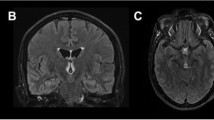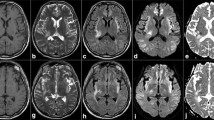Abstract
Background
Acquired hepatocerebral degeneration (AHD) is now widely recognized by physicians. Although hyperintensity in the bilateral globus pallidus in T1-weighted magnetic resonance images (MRIs) are characteristic neuroimaging findings, accumulating reports indicate that atypical neuroimaging findings are not rare. This study aimed to describe the spectrum of atypical neuroimaging findings and related factors in patients with AHD.
Methods
From February 2017 to January 2019, a retrospective study was conducted of 28 patients with AHD in the Shengjing Hospital of China Medical University. The neurological manifestations, clinical parameters, and biochemical and neuroimaging findings were analyzed.
Results
Among 28 patients, 14 patients were diagnosed with viral hepatitis-caused hepatocirrhosis, which was the most common cause of AHD. Resting tremor, cognitive impairment, and parkinsonian gait were the most common neurologic symptoms. Bilateral globus pallidus T1-weighted hyperintensity was detected in 26 patients (26/28, 92.9%). Ten patients (10/28, 35.7%) were determined to have an atypical neuroimaging finding. Binary logistic regression analysis indicated that age at onset of neurologic symptoms (odds ratio = 1.29, 95% confidence interval [CI] 1.03–1.61; p = 0.030) and Child–Pugh scores (odds ratio = 2.52, 95% CI, 1.01–6.31; p = 0.048) were independently associated with atypical neuroimaging findings in AHD.
Conclusion
The clinical manifestations of AHD are diverse; resting tremor, cognitive impairment, and parkinsonian gait were the most common. More than one third of patients had atypical neuroimaging findings. Age at onset of neurologic symptoms and Child–Pugh scores may be important predictors of atypical neuroimaging findings in patients with AHD.





Similar content being viewed by others
References
Maffeo E, Montuschi A, Stura G, Giordana MT (2014) Chronic acquired hepatocerebral degeneration, pallidal T1 MRI hyperintensity and manganese in a series of cirrhotic patients. Neurol Sci 35(4):523–530. https://doi.org/10.1007/s10072-013-1458-x
Shin H-W, Park HK (2017) Recent updates on acquired Hepatocerebral degeneration. Tremor Other Hyperkinet Mov (N Y) 7:463–463. https://doi.org/10.7916/d8tb1k44
Fernandez-Rodriguez R, Contreras A, de Villoria JG, Grandas F (2010) Acquired hepatocerebral degeneration: clinical characteristics and MRI findings. Eur J Neurol 17(12):1463–1470. https://doi.org/10.1111/j.1468-1331.2010.03076.x
Kulisevsky J, Pujol J, Junque C, Deus J, Balanzo J, Capdevila A (1993) MRI pallidal hyperintensity and brain atrophy in cirrhotic patients: two different MRI patterns of clinical deterioration? Neurology 43(12):2570–2573. https://doi.org/10.1212/wnl.43.12.2570
Iwasa M, Mifuji-Moroka R, Kuroda M, Moroka H, Fujita N, Kobayashi Y, Adachi Y, Gabazza EC, Matsuda H, Takei Y (2012) Regional reduction in gray and white matter volume in brains of cirrhotic patients: voxel-based analysis of MRI. Metab Brain Dis 27(4):551–557. https://doi.org/10.1007/s11011-012-9314-x
Park SA, Heo K (2004) Prominent cerebellar symptoms with unusual magnetic resonance imaging findings in acquired hepatocerebral degeneration. Arch Neurol 61(9):1458–1460. https://doi.org/10.1001/archneur.61.9.1458
Meissner W, Tison F (2011) Acquired hepatocerebral degeneration. Handb Clin Neurol 100:193–197. https://doi.org/10.1016/b978-0-444-52014-2.00011-2
Christensen E (2004) Prognostic models including the Child-Pugh, MELD and Mayo risk scores - where are we and where should we go? J Hepatol 41(2):344–350. https://doi.org/10.1016/j.jhep.2004.06.005
Renjen PN, Khanna L, Rastogi R, Khan NI (2013) Acquired hepatocerebral degeneration. BMJ Case Rep 2013:bcr2013009387. https://doi.org/10.1136/bcr-2013-009387
Nagappa M, Sinha S, Saini JS, Kallolimath P, Singh N, Kumar A, Bindu PS, Taly AB (2016) Non-Wilsonian hepatolenticular degeneration: clinical and MRI observations in four families from south India. J Clin Neurosci 27:91–94. https://doi.org/10.1016/j.jocn.2015.06.035
Hisahara S, Matsushita T, Kitamura M, Mezawa S, Nonaka M, Imai T, Shimohama S (2014) Long-term clinical and radiological improvement of chronic acquired hepatocerebral degeneration after obliteration of portosystemic shunt: report of a case. J Neurol Sci 346(1–2):303–306. https://doi.org/10.1016/j.jns.2014.07.068
Rajoriya N, Brahmania M, Feld JJ (2018) Implications of manganese in chronic acquired hepatocerebral degeneration. Ann Hepatol 18(1):274–278. https://doi.org/10.5604/01.3001.0012.7938
Rose CF, Verkhratsky A, Parpura V (2013) Astrocyte glutamine synthetase: pivotal in health and disease. Biochem Soc Trans 41:1518–1524. https://doi.org/10.1042/bst20130237
Stracciari A, Mattarozzi K, D'Alessandro R, Baldin E, Guarino M (2008) Cognitive functioning in chronic acquired hepatocerebral degeneration. Metab Brain Dis 23(2):155–160. https://doi.org/10.1007/s11011-008-9088-3
Butterworth RF (2016) Pathogenesis of hepatic encephalopathy in cirrhosis: the concept of synergism revisited. Metab Brain Dis 31(6):1211–1215. https://doi.org/10.1007/s11011-015-9746-1
Melzer N, Grimm A, Meuth SG, Solymosi L, Stoll G (2010) A pure cerebellar syndrome with corresponding ponto-cerebellar atrophy in acquired hepatocerebral degeneration. J Neurol Sci 292(1–2):96–98. https://doi.org/10.1016/j.jns.2010.02.022
Victor M, Adams RD, Cole M (1965) The acquired (non-Wilsonian) type of chronic hepatocerebral degeneration. Medicine 44(5):345–396. https://doi.org/10.1097/00005792-196509000-00001
Ravina BM, Lange N, Marek K, Holloway R, Eidelberg D (2005) The role of radiotracer imaging in Parkinson disease - reply. Neurology 65(7):1144–1145. https://doi.org/10.1212/01.WNL.0000149403.14458.7F
Kreis R, Ross BD, Farrow NA, Ackerman Z (1992) Metabolic disorders of the brain in chronic hepatic encephalopathy detected with H-1 MR spectroscopy. Radiology 182(1):19–27. https://doi.org/10.1148/radiology.182.1.1345760
Erro R, Vitale C, Picillo M, Barone P, Pellecchia MT (2013) Early MRI findings in acquired hepatocerebral degeneration. Neurol Sci 34(4):589–591. https://doi.org/10.1007/s10072-012-1087-9
Cerase A, Rubenni E, Rufa A, Vallone I, Galluzzi P, Coratti G, Franchi F, Giannini F, Venturi C (2011) CT and MRI of Wernicke's encephalopathy. Radiol Med 116(2):319–333. https://doi.org/10.1007/s11547-011-0618-x
Muccio CF, De Lipsis L, Belmonte R, Cerase A (2019) Reversible MR findings in Marchiafava-Bignami disease. Case Rep Neurol Med 2019:1951030. https://doi.org/10.1155/2019/1951030
Author information
Authors and Affiliations
Corresponding author
Ethics declarations
Conflict of interest
The authors declare that they have no conflicts of interest.
Ethical approval
All procedures performed in the studies involving human participants were in accordance with the ethical standards of the institutional and/or national research committee and with the 1964 Helsinki Declaration and its later amendments or comparable ethical standards. For this type of study, informed consent is not required.
Additional information
Publisher’s note
Springer Nature remains neutral with regard to jurisdictional claims in published maps and institutional affiliations.
Rights and permissions
About this article
Cite this article
Dong, X., Nao, J. Atypical neuroimaging findings in patients with acquired hepatocerebral degeneration. Neurol Sci 41, 175–181 (2020). https://doi.org/10.1007/s10072-019-04068-y
Received:
Accepted:
Published:
Issue Date:
DOI: https://doi.org/10.1007/s10072-019-04068-y




